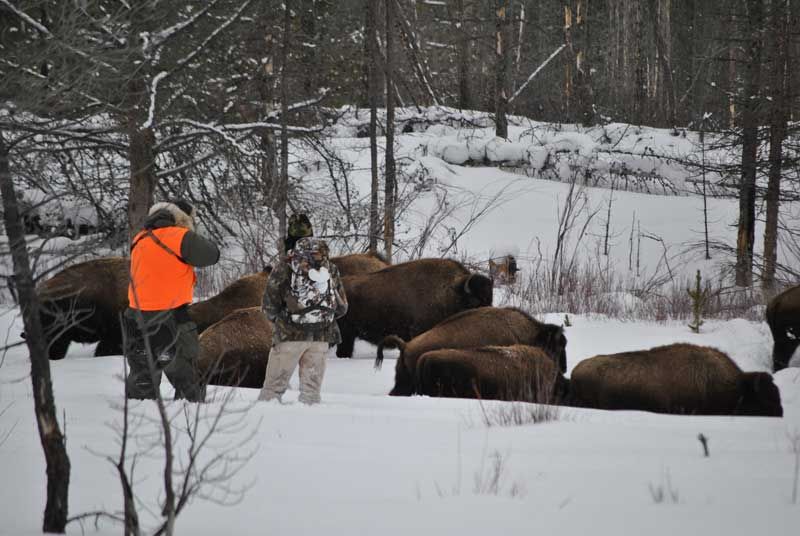by Max Wilbert / Deep Green Resistance
This morning, I spent four hours lost in an industrial neighborhood in Pocatello, Idaho. I was carrying two bags and a box full of food—altogether about 70 or 80 pounds—the wind was howling through the flat grey morning, and I must have covered five miles before I found the coffee shop that I’m sitting in right now.
Explaining why I am here requires that we go back almost 200 years. By the mid-1800’s, the U.S. empire was growing rapidly and expanding west. As guns and horses spread across the Great Plains, bison herds began to fall to hunters and settler-colonists in need of hides. At the same time, industrialism was expanding. Factories used buffalo leather straps as a strong yet elastic material to drive belts on their machines, which means that the bison were literally killed to drive machines.
By the year 1902, there were only 23 bison alive on this continent who took refuge in Pelican Valley in what is now Yellowstone National Park. This means that between 30 and 60 million had been killed in less than 100 years, most of them in less than 20 years. That’s a survival rate of less than one in ten million, or 0.0000007 percent.
The removal of the bison allowed cattle ranching to expand and allowed the U.S. army to force the powerful plains nations onto reservations. The removal of the native nations to reservations via a series of concentration camps allowed settlers to move in.
Over time, with the establishment of Yellowstone National Park and surrounding wilderness areas, the last 23 bison were able to expand their populations. Today, there are around 4,700 bison in the Yellowstone area who are direct descendants of those final 23 survivors.
At this point, you might be forgiven for thinking that as a society, we’ve learned better, and now we protect wild buffalo—especially within Yellowstone. The reality is the opposite. Over the past 33 years, government agencies including the National Parks Service and U.S. Fish and Wildlife Service have used our tax dollars to kill more than 10,000 wild bison in and around Yellowstone. In service of livestock interests, Yellowstone National Park has, in the words of my friend Stephany Seay, “more wild buffalo blood on their hands than anyone since the 19th century."
Today the U.S. Government continues its 200-year-old war against the bison by herding, baiting, and hazing them into a trap located on the North Side of Yellowstone National Park. Here, they are kept for months, subjected to invasive medical procedures (including sterilization experiments), and then murdered. In the past few months, 169 bison have been killed (and counting).
The justification for this slaughter is misguided “management plans” which are heavily influenced—written, more or less—by the ranching industry lobbyists. As was true in the 1800’s, cattle reign supreme in Montana today, and bison pay the price. Idaho is the same. They have a “zero tolerance policy,” which means that any buffalo who enter Idaho are tracked down and killed.
Just so we’re clear, this slaughter is preventing the Yellowstone bison herds from naturally expanding their population into suitable habitat in adjacent National Forests. There is enough land and food and water for the bison, but the cattle barons want all of it
I’ve written and said many times before that we’re living in a war, and that the dominant culture (capitalism, industrialism, civilization, whatever you want to call it) is destroying the planet.
Most people in this culture don’t acknowledge this war, and as the saying goes, “silence is complicity.” Once you understand this war, continuing to stand aside is a betrayal to the planet. There are, however, thousands of people around the world who do acknowledge that this is a brutal war, and that we need to fight back.
These people include the organizers of Buffalo Field Campaign. Buffalo Field Campaign is a grassroots campaign that was founded by Lakota activist Rosalie Little Thunder and activist videography Mike Maese in the winter of 1996-7, when more than a thousand bison were slaughtered by the National Parks Service and Montana Department of Livestock.
Over the intervening 21 years, Buffalo Field Campaign has worked through advocacy, whistleblowing, lawsuits, and direct action to protect the last remaining wild bison in Yellowstone.
I’m on my way right now to Yellowstone. I don’t have a car to travel with, so I rented a one-way vehicle to Pocatello, where another group of friends will pick me up. There are seven or eight of us converging on Yellowstone to express our solidarity, bring donations and supplies, and join in the fight to protect bison.
I’ve often heard the saying that the life of a soldier is 99 percent waiting, and one percent overwhelming terror. In my experience, the life of a revolutionary organizer in the modern world is much the same. We need to prepare, write, organize, build our groups and political consciousness, and gain more resistance skills. Much of this work is boring, dangerous, or downright exhausting.
This morning, after driving through the day yesterday and sleeping on a friend’s grandmother’s couch (thanks for the bag lunch, Lois!), I woke up before 6, jumped in the car, and drove the middle leg of my trip. After dropping the rental car in a tiny, dingy office in the middle of an industrial park covered in trash and tumbleweeds, I had two options: sit awkwardly in the corner for a few hours, or shoulder all my bags, zip up my down jacket, grab my food box, and push open the squealing front door, and try to find my ways sans-GPS to a coffeeshop to get some writing done.
That’s why I was lost on the streets of Pocatello, Idaho this morning.
